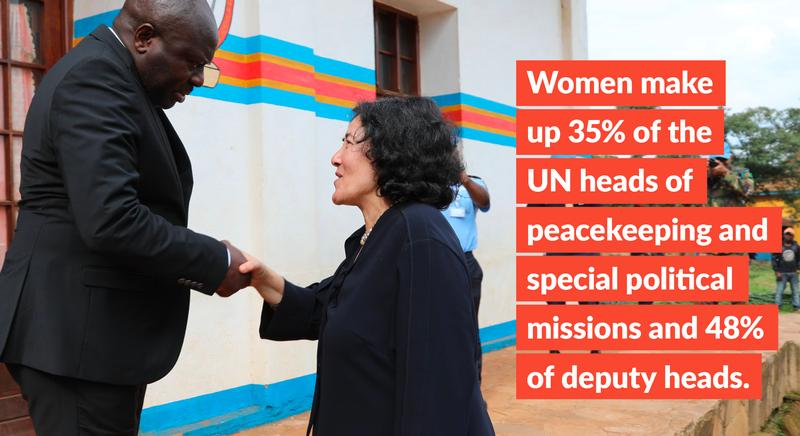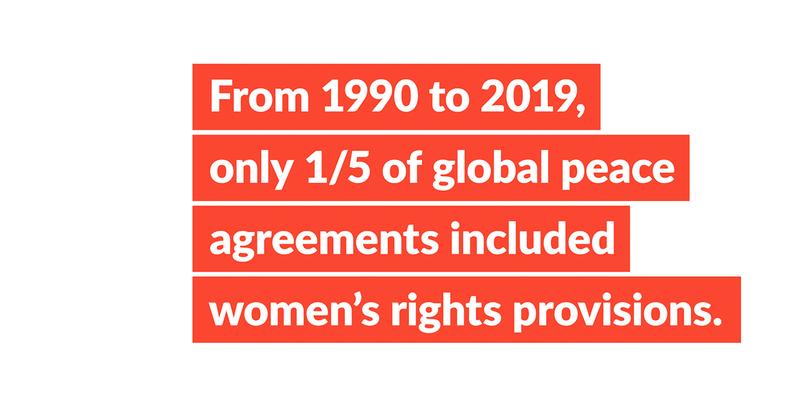UN Security Council Resolution 1325: Peacebuilding in Africa 20 years after its adoption
Women still do not have a seat at the table
UNSCR 1325: Lacking the power to drive change?
Women’s role in informal peacebuilding strategies
How to cite this publication:
Aili Mari Tripp (2020). UN Security Council Resolution 1325: Peacebuilding in Africa 20 years after its adoption. Bergen: Chr. Michelsen Institute (CMI Brief 2020:08)
20 years ago the United Nations Security Council adopted Resolution 1325. The resolution underscored the important role of women in the prevention and resolution of conflicts and called for their equal participation in peacebuilding. The progress since its adoption has been underwhelming. This brief explores the barriers that prevent successful implementation of UNSCR 1325, and provides examples showing why women’s role in peacebuilding processes should not be underestimated.
Women still do not have a seat at the table
Just as conflict is gendered, so is peacebuilding. Women are largely excluded from formal processes. They are often pushed to the sidelines or relegated to informal local level strategies. Not only are women grossly underrepresented as peacekeepers, in peace negotiations, and other aspects of peacebuilding, but the peacebuilding activities they engage in, ranging from demonstrations to promoting arms confiscation, are often ignored, even as they build bridges across ethnic, religious, and political divisions.
When UNSCR 1325 first was adopted, hopes were high that this would change. Yet, 20 years later women’s presence in formal peace processes is still minimal.

After the United Nations Security Council Resolution (UNSCR) 1325 was adopted in 2000, the numbers increased, but by 2019 women made up only 4.7 percent of military personnel and 10.8 percent of police personnel in UN Peacekeeping Missions.

Female representation in peace negotiations is equally low. A 2019 study found that women were signatories to only 13 out of 130 peace agreements from 1990 to 2014, with no increase in the numbers since 2000, when UNSCR 1325 was passed (Krause, Krause and Bränfors 2018). According to the Council on Foreign Relations, between 1992 and 2018, women made up 13 per cent of the negotiators, 3 per cent of the mediators and only 4 per cent of the signatoriesin major peace processes.[1]As Mollie Pepper puts it, women are placed “around the table,” rather than at the table (Pepper 2018). Only three women have served as chief mediators at the international level.
When it comes to women’s rights, UNSCR 1325 has a similarly poor track record. According to the University of Edinburgh Peace Agreements Database, between 1990 and 2019, only one fifth of the global peace agreements included women’s rights provisions. In Africa, where the number of provisions is higher than in other parts of the world, such provisions increased after UNSCR 1325 from an average of 19 percent of the peace accords between 1995-1999 to 35 percent after 2005, but it has remained at that level ever since.
UNSCR 1325: Lacking the power to drive change?
The Women, Peace and Security agenda (WPS) emerged in the context of the adoption of UNSCR 1325. It was further institutionalized as countries adopted National Action Plans as part of their commitment to the resolution. By May 2020, at least 84 countries (43 percent of UN member states) had developed National Action Plans for the implementation of UNSCR 1325 on Women, Peace and Security. Some regional organizations like the Economic Community of West African States and the African Union have also adopted Regional Action Plans.
However, action ensuring the implementation of UNSCR 1325 has yet to come. Only 34 percent of the countries that have adopted NAPs have a budget allocated for its implementation.
The continued failure to implement UNSCR 1325 has dramatic consequences on several levels; one being the success of peacebuilding processes. A number of studies indicate that the potential losses of not including women are immense. Nilsson (2012) shows that when civil society actors are included in peace agreements, the risk of peace failing is reduced by 64 percent, regardless of regime type. Another study similarly found that between 1998 and 2011, peace agreements that had women signatories were linked to durable peace and a higher rate of implementation of the peace agreement (Krause, Krause and Bränfors 2018). Yet, only 75 percent of the National Action Plans for the implementation of UNSCR 1325 delineate a specific role to civil society.[2]
UNSCR 1325 has also been critiqued for not living up to its mandate because it has no teeth nor accountability mechanisms (Willett 2010). It has been roundly criticized for treating women primarily as victims and not as agents in fighting for peace, and for not challenging the militarization project.

Peacebuilding is seen as costly and time-consuming. Therefore a greater emphasis is put on stabilization and counter-terrorism strategies, further impeding women’s efforts to influence peacebuilding. The United Nations has focused more on stabilization missions and the UN Security Council has given larger mandates to field missions. This new counter-terrorism strategy leaves women’s activism and civil society with even less influence in spite of strong evidence that the participation of civil society enhances the sustainability of peacebuilding efforts. Today, the international focus is on killing and capturing enemy targets rather that tackling the underlying structural and institutional problems that give rise to conflict in the first place. Subsequent peacebuilding efforts have focused on state-building and technocratic solutions and have generally excluded grassroots activities (Mac Ginty and Firchow 2016).
The resolution has been criticized by feminist scholars for confusing “women” with “gender,” by not accounting for the ways in which women contribute to conflict or for how men are also in need of security, nor does it account for the role of masculinity in conflict. Others argue that it does not look at the structural dimensions of women’s inequality and how gender equality is at the heart of understanding women and security (Shepherd 2008). Some claim that a one-sided focus on sexual violence has led to the exclusion of other issues relating to women and conflict (Engle 2014). Additionally, if women are seen only as victims, it is harder to make them equal partners in key decision-making bodies when negotiating peace. If women are not also seen as fighters, they are ignored by Disarmament, Demobilization and Reintegration (DDR) programs. If men are only seen as fighters, it is harder to protect them as civilians.
Women’s role in informal peacebuilding strategies
Women’s organizations’ persistent work to get a seat at the table and influence formal peace talks are often ignored. So are their concrete contributions to informal grassroots peacebuilding.
Despite being excluded from formal peace processes, women have participated in a wide range of activities: they have organized rallies and boycotts, promoted small arms confiscation (e.g., Mali), conducted reconciliation ceremonies (northern Uganda), negotiated with small groups of rebels to disarm (e.g., Liberia), and negotiated with rebels to release abducted children and child soldiers (e.g., Somalia, northern Uganda, and northern Nigeria). Peace activists have played a role in preventing the resumption of conflict in various contexts by monitoring and advocating against the sale of small arms, carrying out conflict resolution workshops, participating in campaigns for clean diamonds and protesting the role of coltan in the conflict in DR Congo. Other strategies during war range from collecting arms to media work, especially through the radio (Tripp et al. 2009).
Liberian women famously demonstrated for rapid conclusion of peace talks in Accra in 2003, when the civil war worsened. At various times women activists advocated for the holding of peace talks, the holding of elections (e.g., Sierra Leone in 1996), the holding of free and fair elections without interference from militia (e.g., Mozambique in 1994), the delay of elections until soldiers were fully demobilized (e.g., Liberia in 2003), and the demobilization of soldiers with the assistance of civil society and women’s organizations (e.g., Liberia in 1996 and 2003).
In the case of Maduguiri, northern Nigeria, local women’s organizations negotiated with state security and vigilante groups to allow families to get their kidnapped children returned by Boko Haram. They provided information about suspicious movements related to Boko Haram in collaboration with state security and vigilante groups. They made efforts to bring repenting Boko Haram representatives and the government together to the negotiating table. They formed groups that advocated for peace and respect in local communities, and organized rallies for peace. The woman’s organizations advocated for and provided psycho-social support for women survivors of abuse and mediated and built community support for pregnant women or children whose husbands and fathers are/were members of Boko Haram. Finally, they organized to provide foster parents for unaccompanied children whose parents were either killed or missing.
In South Sudan in 2013 women from both Sudan and South Sudan lobbied their respective governments and the international community for a role for women in the peace negotiations and in processes directed by the African Union. They demanded to have a say in shaping their future priorities of the two countries and condemned the exclusive nature of the process and the lack of transparency. They formed a Coalition of Women Leaders from Sudan and South Sudan at the 20th African Union Summit held in Addis Ababa, Ethiopia, in January 2013. They made concrete policy proposals on a wide range of issues and demanded women’s representation in various bodies involved in implementing the peace agreement. They were especially concerned with how to address women’s security: how the military and police forces needed to be trained to be sensitized to women’s safety.
Later a South Sudan Women’s Coalition for Peace of 50 organizations continued to lobby the South Sudanese government for women to take part in the revitalization process as negotiators and as part of the technical support team. They called for more women in the Intergovernmental Authority on Development (IGAD) Secretariat, more gender experts in the IGAD Special Envoys Office and the Joint Monitoring and Evaluation Commission. As a result, the 2017 High Level Revitalization Process included eleven women as full delegates out of 90, unlike the 2015 process, where women were only observers. By February 2018 the number was increased to 23 and by the time of the Addis Ababa talks in May 2018, there were 39 female delegates out of 120 participants, or one third. They demanded that the transitional government include 35 percent women and, in the end, the Revitalized Transitional Government of National Unity (R-TGoNU) formed on February 22, 2020, included twelve women out of 35 in cabinet posts, three positions short of their demand of 35 percent. The Coalition doggedly continued to press for a minimum of 35 percent women in parliament and all other governmental bodies, and insisted that the parties begin to address the issues underlying the conflict which had to do with corruption, tribalism and impunity. The South Sudanese women activists would not have got this far without their persistence and insistence on inclusion at every step of the way.
Building alliances across difference
One of the most striking features of women’s mobilization in Africa and elsewhere is their capacity to mobilize across ethnic, clan, racial, religious, class and other differences. They have joined forces because of their shared experiences and common demands in the context of war and its aftermath. Naturally there have been tensions and challenges to such mobilization but creating alliances has been an enduring feature of the mobilization even in contexts where such alliances were highly unlikely. In Liberia, women peacemakers during the civil war came together across class, religious and ethnic divisions in society. In Somalia, it was across clan lines, while in Rwanda and Burundi it was across ethnic lines.
Nigeria’s population is evenly divided between Muslims (48 percent) and Christians (49 percent). Boko Haram has attacked both Christians and Muslims, convincing women’s organizations to combine forces to find ways to create more tolerant communities and build peace. Women’s organizations throughout the northern states affected by Boko Haram attacks have built alliances across religious differences. When in 2014 over 300 girls were abducted by Boko Haram in Chibok, Borno State, a coalition of Borno women’s rights groups, both Christian and Muslim, came out in full force to protest the abductions. The head of Nigeria’s Market Women’s Association ordered the closing of six major Lagos open air markets. A Network of Civil Society Organizations in Borno State (NECSOB), directed by a woman Fatima Shehu Imam, mobilized along inter-faith lines to provide humanitarian aid and assistance to victims of the insurgency. Other groups throughout the country emerged to build linkages along similar lines.
These successful alliances point to important resources that have been overlooked in peacebuilding efforts. The pursuit of a common cause is the starting point, not the end point as it so often is in military strategies or peace negotiations. These powerful initiatives are based on knowledge about the stakeholders and the local dynamics at play. They are creative efforts to address the underlying causes that have given rise to violence.
Conclusion
Women’s peacebuilding initiatives, both formal and informal, need to be accounted for and incorporated into a broadened definition of peacebuilding. Their inclusion is important because it is a step toward gender equality. Including women’s organizations and activists helps ensure a more lasting peace and helps break the cycle of violence. As evident in this brief, women often come together across class, ethnic, religious and political differences to build coalitions around their common grievances. Many of these have had to do with violence, sexual violence, access to land and political power. For example, in the demands of the South Sudanese women, they have insisted that the conditions that have given rise to the conflict must be directly addressed. These conditions include corruption, tribalism, and impunity. Women activists can make these demands as they have much less at stake than male leaders in preserving the status quo and little to lose. And far from seeing themselves only as victims, local women activists often come together around quotidian concerns that have to do with accessing food, water and shelter. Who better to consult with than those who know the local dynamics? Who better to bring into formal reconciliation processes than those who have already succeeded in building bridges?
Notes
[1] Council on Foreign Relations (accessed on 23 October 2019). Women’s Participation in Peace Processes.






